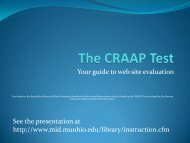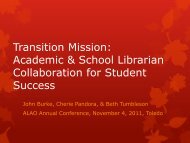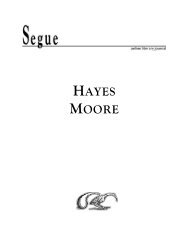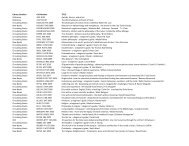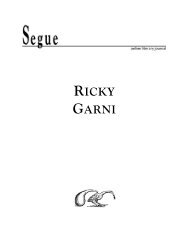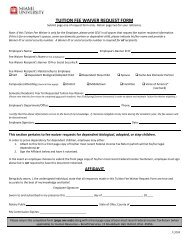Bibliography of Assessment Alternatives: Portfolios
Bibliography of Assessment Alternatives: Portfolios
Bibliography of Assessment Alternatives: Portfolios
Create successful ePaper yourself
Turn your PDF publications into a flip-book with our unique Google optimized e-Paper software.
Gearhart, Maryl, Joan Herman, Eva Baker, and Andrea Whittaker. Writing <strong>Portfolios</strong> at<br />
the Elementary Level: A Study <strong>of</strong> Methods for Writing <strong>Assessment</strong>, 1992. Available<br />
from: National Center for Research on Evaluation, Standards, and Student Testing,<br />
UCLA Graduate School <strong>of</strong> Education, 145 Moore Hall, 405 Hilgard Ave., Los Angeles,<br />
CA 90024, (310) 206-1532.<br />
The authors reported on a study that addressed the following questions: (1) Can portfolios be<br />
scored reliability? (2) Are such judgments valid? (3) Are students scored comparably on<br />
their portfolios and other writing assessments? (4) How did raters feel about scoring<br />
portfolios?<br />
Results showed that: (1) holistic ratings <strong>of</strong> portfolios and class work can be very reliable; (2)<br />
raters tended to rate the portfolio as a whole higher than the average <strong>of</strong> the scores on<br />
individual pieces <strong>of</strong> work in the portfolio (raising the possibility that additional factors are at<br />
work); (3) portfolio scoring has promise provided that teachers and students know the criteria<br />
so that they can select content. This report also provides the scoring guide (but no sample<br />
student work) that was used to score individual pieces <strong>of</strong> work and the portfolio as a whole.<br />
(AL# 470.3WRIPOE)<br />
Gentile, Claudia A., James Martin-Rehrmann, and John H. Kennedy. Windows into the<br />
Classroom, January 1995. Available from: Education Information Branch, Office <strong>of</strong><br />
Educational Research and Improvement, US Department <strong>of</strong> Education, 555 New Jersey<br />
Ave, NW, Washington, DC 20208, (800) 424-1616, (202) 219-1651.<br />
This report describes the classroom writing <strong>of</strong> American schoolchildren based on a survey<br />
conducted in 1992 by the National <strong>Assessment</strong> <strong>of</strong> Educational Progress (NAEP). It examines<br />
the types <strong>of</strong> writing students perform in school, the quality <strong>of</strong> their classroom writing, the<br />
relationship between their classroom writing and their performance on the NAEP writing<br />
assessment, and instructional factors related to portfolio performance.<br />
To conduct this study, NAEP asked a nationally representative subgroup <strong>of</strong> the fourth and<br />
eighth graders who participated in the 1992 NAEP writing assessment to submit three pieces<br />
<strong>of</strong> writing from their Language Arts or English classes that represented their best writing<br />
efforts. Student papers were scored using holistic, primary trait rubrics. Results showed that:<br />
• At both fourth and eighth grades, the majority <strong>of</strong> the students submitted narrative and/or<br />
informative writing.<br />
• In general, students who spent more time on writing, in school and out <strong>of</strong> school,<br />
performed better on their portfolio writing. Also, students who were asked to write papers<br />
<strong>of</strong> medium and long lengths, at least once or twice a month, performed better than those<br />
who rarely or never did so.<br />
The report includes rubrics, statistics, and samples <strong>of</strong> student work.<br />
<strong>Assessment</strong> Resource Library, (503) 275-9582 31 Portfolio <strong>Bibliography</strong><br />
(formerly Test Center) NWREL, December 1996




